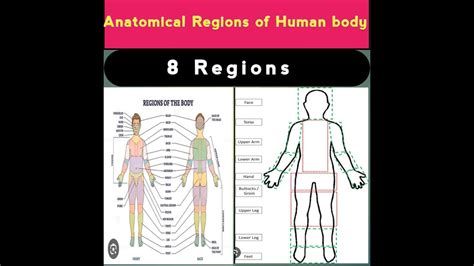The human body is a complex and fascinating machine, composed of trillions of cells that work together in harmony to perform a wide range of functions. These cells are organized into tissues, which are in turn organized into organs, and finally into systems. The human body can be divided into five main regions: the head, neck, trunk, upper limbs, and lower limbs.

Head
The head is the uppermost region of the body and contains the brain, the eyes, the ears, the nose, and the mouth. The brain is the control center of the body and is responsible for processing information, controlling movement, and regulating bodily functions. The eyes allow us to see, the ears allow us to hear, the nose allows us to smell, and the mouth allows us to eat and speak.
Neck
The neck is the region of the body that connects the head to the trunk. It contains the trachea, which allows air to enter and exit the lungs, and the esophagus, which allows food and liquids to enter the stomach. The neck also contains the thyroid gland, which produces hormones that regulate metabolism.
Trunk
The trunk is the largest region of the body and contains the chest, the abdomen, and the pelvis. The chest contains the heart, the lungs, and the esophagus. The abdomen contains the stomach, the small intestine, the large intestine, the liver, and the pancreas. The pelvis contains the bladder, the uterus, and the rectum.
Upper Limbs
The upper limbs consist of the arms, the forearms, and the hands. The arms allow us to reach, grab, and lift objects. The forearms allow us to rotate our hands and wrists. The hands allow us to grip objects, manipulate objects, and write.
Lower Limbs
The lower limbs consist of the thighs, the legs, and the feet. The thighs allow us to walk, run, and jump. The legs allow us to bend our knees and ankles. The feet allow us to stand and walk.
The following table provides a summary of the different human body regions and their functions:
| Region | Function |
|---|---|
| Head | Contains the brain, eyes, ears, nose, and mouth |
| Neck | Connects the head to the trunk |
| Trunk | Contains the chest, abdomen, and pelvis |
| Upper limbs | Allow us to reach, grab, and lift objects |
| Lower limbs | Allow us to walk, run, and jump |
Understanding the different human body regions is important for a number of reasons. First, it can help us to better understand how the body works and how to keep it healthy. Second, it can help us to identify and treat injuries and illnesses more effectively. Third, it can help us to communicate more effectively with healthcare professionals.
The human body is a complex and fascinating machine, and understanding its different regions is essential for maintaining good health and well-being. By learning more about the human body, we can better appreciate its amazing capabilities and take steps to protect it from injury and illness.
